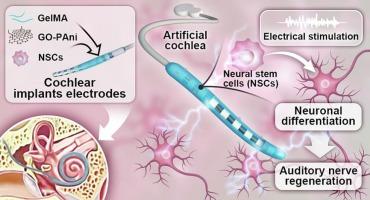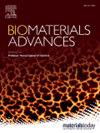Preparation and characterization of neural stem cell-loaded conductive hydrogel cochlear implant electrode coatings
IF 5.5
2区 医学
Q2 MATERIALS SCIENCE, BIOMATERIALS
Materials Science & Engineering C-Materials for Biological Applications
Pub Date : 2024-11-08
DOI:10.1016/j.bioadv.2024.214109
引用次数: 0
Abstract
Sensorineural deafness is a hearing impairment resulting from damage to the auditory nerve or inner ear hair cells. Currently, cochlear implants (CIs) are widely used as hearing aids for sensorineural deafness patients. A fundamental limitation of cochlear implants (CIs) is that spiral ganglion neurons (SGNs) cannot be replenished. This greatly restricts the rehabilitation of sensorineural deafness. Additionally, the insertion of CIs can cause secondary cochlear damage, worsening the condition of the patients' cochlear. Therefore, a new type of neural stem cells (NSCs) loaded graphene oxide-polyaniline/GelMA (GO-PAni/GelMA) conductive hydrogel electrode for cochlear implant was fabricated via in-situ radical polymerization and cyclic UV curing technique. On the one hand, the hydrogel electrode, as a direct contact layer, helps to avoid the physical hurt for cochlear. On the other hand, NSCs were supplemented via the hydrogel carrier and neuronal differentiation was induced by electrical stimulation, which was validated by the experimental results of immunofluorescence, Phalloidin Staining and RT-qPCR. Furthermore, based on RNA sequencing and transcriptome analysis, we hypothesized that the neuronal differentiation of NSCs was adjusted by the calcium signaling pathway and GABAergic synapse. Overall, our cell loading conductive hydrogel electrode may be an effective solution to sensorineural deafness. The revelation of the mechanism of neuronal differentiation promoted by electrical stimulation provides a basis for further sensorineural deafness treatment using conductive hydrogel CI electrode.

神经干细胞负载导电水凝胶人工耳蜗电极涂层的制备和表征。
感音神经性耳聋是一种因听觉神经或内耳毛细胞受损而导致的听力障碍。目前,人工耳蜗(CI)被广泛用作感音神经性耳聋患者的助听器。人工耳蜗(CI)的一个基本局限是螺旋神经节神经元(SGN)无法补充。这极大地限制了感音神经性耳聋的康复。此外,植入人工耳蜗还会造成继发性耳蜗损伤,使患者的耳蜗状况恶化。因此,本研究通过原位自由基聚合和循环紫外固化技术制备了一种用于人工耳蜗植入的新型神经干细胞负载氧化石墨烯-聚苯胺/凝胶MA(GO-PAni/GelMA)导电水凝胶电极。一方面,水凝胶电极作为直接接触层,有助于避免人工耳蜗受到物理伤害。另一方面,通过水凝胶载体补充 NSCs,并通过电刺激诱导神经元分化,免疫荧光、类球蛋白酶染色和 RT-qPCR 的实验结果验证了这一点。此外,根据 RNA 测序和转录组分析,我们推测 NSCs 的神经元分化是由钙信号通路和 GABA 能突触调节的。总之,我们的细胞负载导电水凝胶电极可能是治疗感音神经性耳聋的有效方法。电刺激促进神经元分化机制的揭示为进一步利用导电水凝胶CI电极治疗感音神经性耳聋提供了基础。
本文章由计算机程序翻译,如有差异,请以英文原文为准。
求助全文
约1分钟内获得全文
求助全文
来源期刊
CiteScore
17.80
自引率
0.00%
发文量
501
审稿时长
27 days
期刊介绍:
Biomaterials Advances, previously known as Materials Science and Engineering: C-Materials for Biological Applications (P-ISSN: 0928-4931, E-ISSN: 1873-0191). Includes topics at the interface of the biomedical sciences and materials engineering. These topics include:
• Bioinspired and biomimetic materials for medical applications
• Materials of biological origin for medical applications
• Materials for "active" medical applications
• Self-assembling and self-healing materials for medical applications
• "Smart" (i.e., stimulus-response) materials for medical applications
• Ceramic, metallic, polymeric, and composite materials for medical applications
• Materials for in vivo sensing
• Materials for in vivo imaging
• Materials for delivery of pharmacologic agents and vaccines
• Novel approaches for characterizing and modeling materials for medical applications
Manuscripts on biological topics without a materials science component, or manuscripts on materials science without biological applications, will not be considered for publication in Materials Science and Engineering C. New submissions are first assessed for language, scope and originality (plagiarism check) and can be desk rejected before review if they need English language improvements, are out of scope or present excessive duplication with published sources.
Biomaterials Advances sits within Elsevier''s biomaterials science portfolio alongside Biomaterials, Materials Today Bio and Biomaterials and Biosystems. As part of the broader Materials Today family, Biomaterials Advances offers authors rigorous peer review, rapid decisions, and high visibility. We look forward to receiving your submissions!

 求助内容:
求助内容: 应助结果提醒方式:
应助结果提醒方式:


